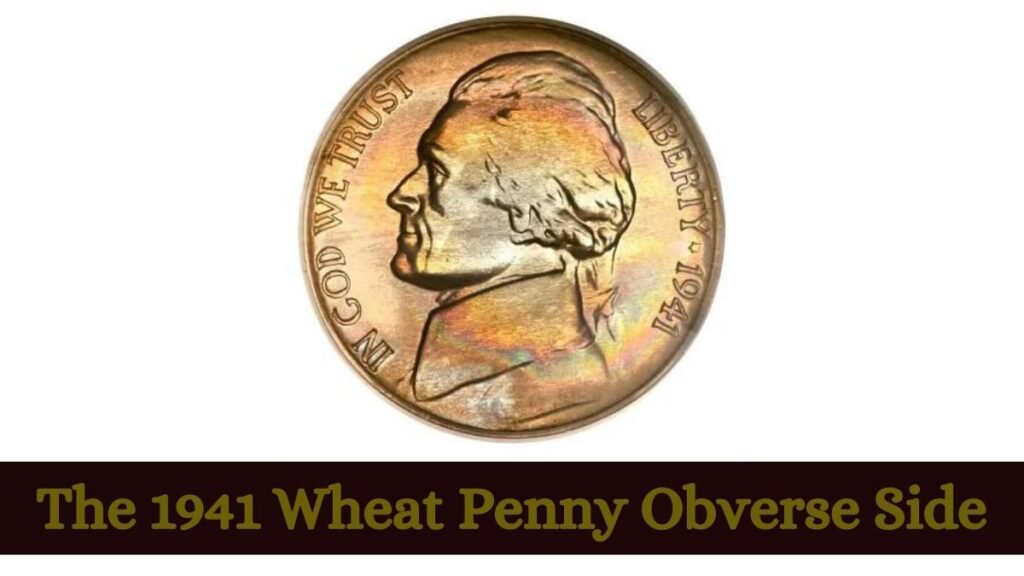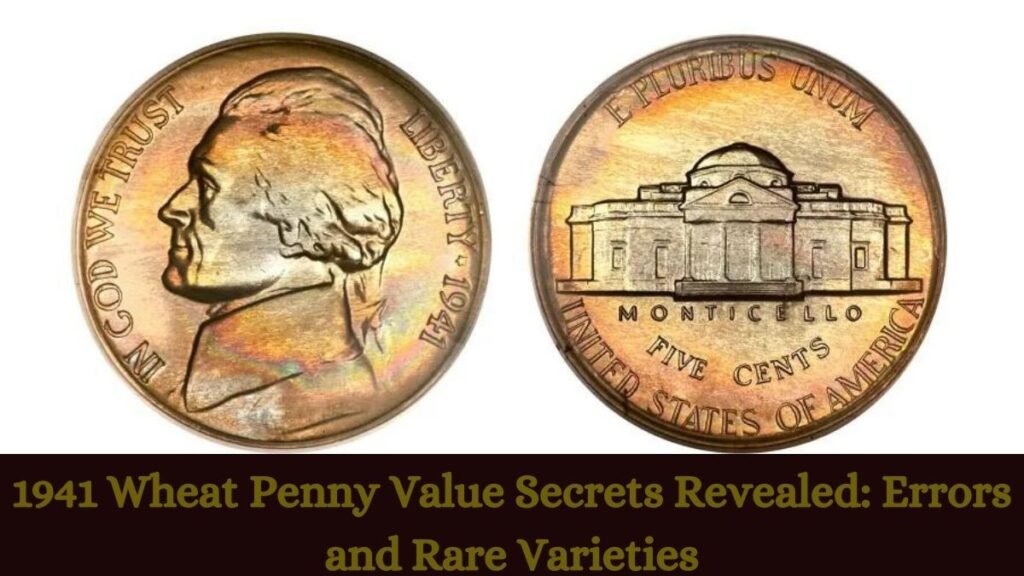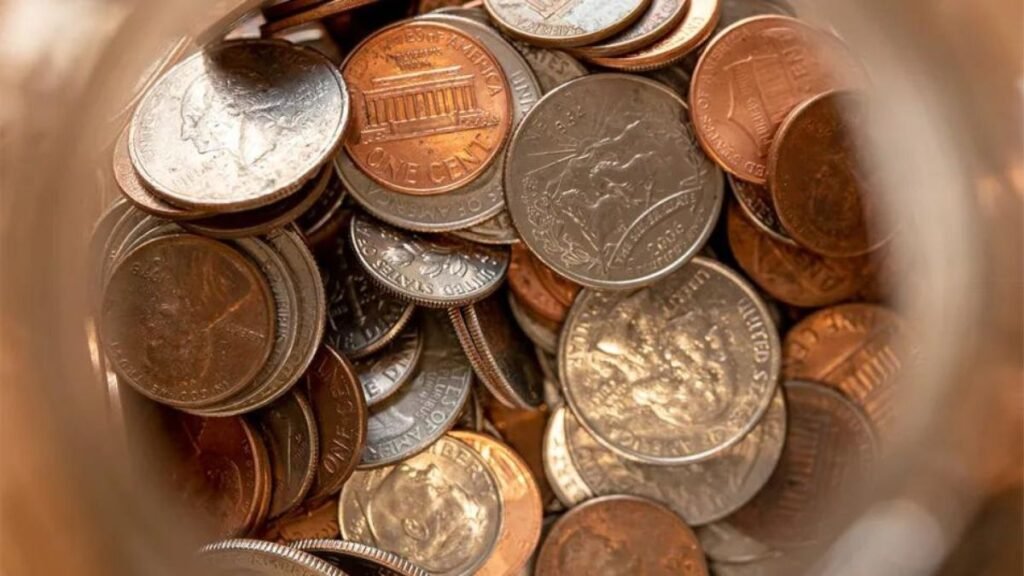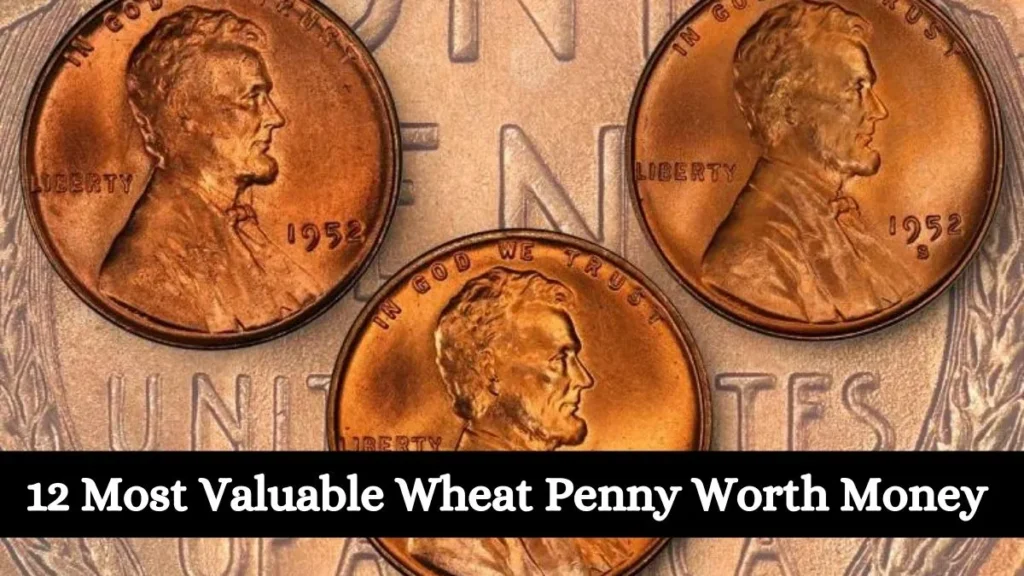The 1941 Wheat Penny is not particularly challenging to find nowadays due to the production of over a billion pieces. The value of a 1941 penny depends on several crucial factors, as many have experienced significant wear over decades in circulation.
Nevertheless, specimens over 80 years old in high grade are considered collectible and potentially valuable. Additionally, collectors often highly appreciate coins with specific and significant errors, so carefully examining your cents can sometimes yield rewarding results.
Also Read Top 100 Valuable Pennies
1941 Wheat Penny Value
| Condition | 1941 No mint mark penny | 1941 D penny | 1941 S penny |
|---|---|---|---|
| Good | $0.17 | $0.17 | $0.17 |
| Very good | $0.20 | $0.20 | $0.20 |
| Fine | $0.23 | $0.23 | $0.34 |
| Very fine | $0.34 | $0.57 | $0.57 |
| Extra fine | $0.69 | $1.16 | $1.16 |
| AU | $1.75 | $3.38 | $3.38 |
| MS 60 | $2.33 | $4.63 | $4.63 |
| MS 63 | $3.38 | $5.84 | $5.84 |
| PR 63 | $46 | / | / |
The 1941 Wheat Penny History
The introduction of the Lincoln cents featuring wheat stalks on the reverse took place in 1909, aiming to commemorate the 100th birth anniversary of one of the most revered American Presidents in history.
Owing to their popularity among collectors, the US Mint initiated the production of proofs in 1936, specifically intended for collectors. This marked the first instance in US history of minting coins solely for the pleasure of collectors, rather than for everyday circulation.
Also Read 1964 Copper Nickel Coin Value Revealed!
1941 Wheat Penny Types
- Philadelphia: 1941 No Mint mark cent – Minted: 887,018,000
- Philadelphia: 1941 proof cent – Minted: 21,100
- San Francisco: 1941 S cent – Minted: 92,360,000
- Denver: 1941 D cent – Minted: 128,700,000
- Total: 1,118,099,100
After a 32-year interval, the 1941 pennies marked a significant period in coin history as the first minted after the attack on American soil. Notably, the year “1941” struck on the obverse adds a unique touch to these coins.
These pennies also hold distinction as among the last made of copper before the U.S. Mint shifted to zinc-plated steel for pennies in 1943, a move aimed at allocating copper resources to support the war effort.
While outwardly similar to other coins in the Wheat series, the 1941 pennies carry historical significance, minted during the Japanese attack on Pearl Harbor and the formal entry of the United States into World War II. These events contribute to their appeal for collectors, both beginners and seasoned enthusiasts.
Despite being part of the 6th highest mintage in Philadelphia, their commonality today is balanced by the historical narrative and the enduring popularity of the entire Wheat series, making them sought-after additions to coin collections.
Also Read 12 Most Valuable Wheat Penny Worth Money
Characteristics Of The 1941 Wheat Penny
The 1941 Wheat cents belong to one of the most beloved coin series in the United States. This series originated in 1909 when President Theodore Roosevelt sought to enhance the artistic quality of American coinage.
Victor Brenner’s design, notably featuring Abraham Lincoln on the obverse, has endured to this day. However, the reverse of these coins saw variations depending on the occasion, reflecting the versatility of the design over the years.
The 1941 Wheat Penny Reverse Side

The 1941 pennies are part of the Wheat series, featuring two wheat stalks on the reverse. These stalks surround two inscriptions divided into four lines:
ONE
CENT
UNITED STATES
OF AMERICA
Additionally, the E PLURIBUS UNUM motto is struck above.
Interestingly, Victor D. Brenner initially intended to depict tree branches on the reverse, but this design was deemed too similar to French coins. Consequently, Mint Director Frank Leach requested a different solution.
There was another issue with the original reverse design. Brenner placed relatively large initials on this side of the coin, and they were promptly removed due to public pressure. These initials only appeared on the obverse in 1918, so you can observe them in cents minted in 1941.
The 1941 Wheat Penny Obverse Side

Like all other pennies, those minted in 1941 feature Abraham Lincoln’s portrait on the obverse side. Designed by Victor D. Brenner, the word “LIBERTY” is placed on the left, behind the President’s back.
The year 1941, representing the minting year, is positioned on the right side, in front of the centrally located image.
Pennies from all mints except Philadelphia have the mint mark below the date. Additionally, all pennies minted in this war year bear the designer’s initials discreetly tucked into the bust’s lower edge.
The composition is framed with “IN GOD WE TRUST” positioned above.
1941 Wheat Penny Details:
- Coin weight: 3.11 g (0.10970 ounces)
- Shape: Round
- Composition: An alloy of 95% copper with zinc or tin
- Coin thickness: 1 mm (0.03937 inches)
- Coin diameter: 19.05 mm (1.75 inches)
- Edge: Plain
- Face value: One cent ($0.01)
Additional Details Regarding The 1941 Wheat Penny
The 1941 cent with wheat stalks on the reverse is a round one-cent coin made of a copper alloy.
It has a thickness of 1 mm (0.03937 inches) and a diameter of 19.05 mm (1.75 inches). This plain-edged coin weighs 3.11 g (0.10970 ounces).
1941 Wheat Penny Grades
The coin grading system for collectible coins ranges from a Basal State-1 to MS 70 (Mint State 70) for the best-preserved pieces without the tiniest flaw. The highest-ranking 1941 pennies are those in MS 68 grade, making them the most valuable in the set.
| # | Grade |
|---|---|
| 1 | Basal State-1 |
| 2 | Fair |
| 3 | Very Fair |
| 4, 5, 6 | Good |
| 7, 8, 10 | Very Good |
| 12, 15 | Fine |
| 20, 30 | Very Fine |
| 40 | Extremely Fine |
| 50 | About Uncirculated |
| 60 | Mint State |
| 65 | Mint State |
| 70 | Mint State |
Please refer to our grading guides to understand your coin scale, as it is a necessary step to determine the exact value of your coin.
Value Guides for 1941 Wheat Penny
The Philadelphia mint was responsible for producing the largest number of pennies in 1941, striking a total of 1,118,099,100 coins. In addition to almost 900 million regular-strike coins, there were also proof coins. The other two mints had significantly lower mintages this year.
1941 Wheat Penny Value Proof
In addition to regular cents without a mint mark, the Philadelphia mint also produced proof coins in 1941. Due to a low mintage of only 21,100 coins, their value can be high, especially for those in the highest grades.
Brown pennies, which are the least desirable among collectors, have the lowest price range, ranging from $18 to $150, depending on quality. Red-brown colored ones are slightly more expensive, and you should budget $25 to $180 to acquire one.
However, the 1941 penny with a PR 67 ranking can be surprisingly valuable, with an average price of $2,000 to $2,400. Red specimens can be even more costly. For instance, you can find them at the following prices:
- PR 61-graded cents: $48 to $50
- PR 62-graded cents: $50 to $60
- PR 63-graded cents: $60 to $72
- PR 64-graded cents: $70 to $85
- PR 65-graded cents: $130 to $156
- PR 66-graded cents: $360 to $432
The most collectible coins are typically those graded PR 67, and they are usually worth $3,500 to $4,500.
1941 Wheat Penny No Mint Mark – Very Rare
The mintage of 887,018,000 pennies in 1941 was exceptionally high, and all those coins originated from Philadelphia. This high mintage contributes to their moderate value on the market.
For brown-colored surfaces, you can find these pennies priced between $0.05 to $3.60, with the cost correlating with the pennies’ appearance. Conversely, red-brown pieces tend to be more expensive, ranging from $2 to $15.
As expected, the most valuable specimens exhibit beautiful red toning. Well-preserved pennies with this feature are available in various grades, leading to a range of prices. Be prepared to budget approximately:
- $3 to $3.60 for an MS 63-ranked penny
- $4 to $4.80 for an MS 64-ranked penny
- $8 to $10 for an MS 65-ranked penny
- $25 to $30 for an MS 66-ranked penny
- $115 to $138 for an MS 67-ranked penny
Interestingly, pennies in the highest possible grade in the set (MS 68) are exceedingly rare, and those minted in Philadelphia can command at least $3,500 each.
1941 D Wheat Penny Value
The mintage of the 1941 D pennies was 128,700,000, and this substantial number contributes to their moderate value in today’s market. Consequently, you can acquire a brown penny minted in this year for $1.75 to $3.60, while those exhibiting red-brown toning are valued at approximately $2 to $15.
Red-colored 1941 cents command slightly higher prices, ranging from $3 to $120. However, some exceptional pieces can be surprising. For example, an owner sold his MS 68-rated penny minted in this year for $6,600 in 2023.
Rare 1941 Wheat Penny Error List
1941 S Wheat Penny Value Chart
The San Francisco mint had the lowest penny mintage of only 92,360,000 coins in 1941. Surprisingly, this lower mintage doesn’t significantly affect their prices. Brown-toned pieces are readily available in the market for $2 to $5. If you’re interested in red-brown specimens, they tend to be slightly pricier, ranging from $3 to $15.
However, the real value jump is seen in the red coins, especially those in the highest grades. Coins rated from MS 63 to MS 66 range from $4 to $40, while those with an MS 67 grade can command prices of $140 to $170 at auctions.
1941 Wheat Penny Worth Million Dollars
Yes, you read that right—a 1941 penny potentially worth a million dollars. It’s the stuff of legends, the kind of discovery that captures imaginations and fuels the hope of uncovering treasures in everyday moments.
In 1941, amidst the turmoil of a world on the brink of war, these pennies were minted. But among the millions produced, only a handful bear the distinct marks, errors, or rarities that elevate them to prized possessions. A minting error, an unusual mark, or even a specific variety could transform an ordinary coin into a collector’s dream.
It’s not just about the monetary value, though. It’s the story behind the discovery—the joy, the disbelief, and the exhilaration of unearthing a piece of history with such incredible worth.
Double Die Obverse
The Double Die Obverse (DDO) is a well-known error found in some 1941 pennies, resulting from the die striking the coin surface more than once. Doubling is typically observed on the LIBERTY and/or IN GOD WE TRUST inscriptions.
These error coins can be quite valuable. Brown pieces with the Double Die Obverse are priced around $80 to $500, while red-brown-toned examples typically command values of $225 to $780. In the case of the 1941 DDO red penny, prices can range from $275 to $2,400, varying based on their grades.
Penny With Digit Shift
It is unusual to encounter an error in the minting year, but among 1941 pennies from the San Francisco mint, some exhibit a distinctive feature—a slightly shifted last digit leaning to the left. These error coins, with the 1941 cent featuring a shifted 1, are valued at approximately $300.
Penny On An Experimental Planchet
The 1941 pennies with the unusual imperfection of a slightly shifted last digit are considered relatively rare. These occurrences took place as the US Mint experimented with various metals due to increased demand for copper during the war effort.
While these pieces are not technically errors but rather experimental coins, they are highly sought after by collectors. In most cases, they contain a lower percentage of copper and can be valued up to $600.
Most Expensive 1941 Wheat Penny
Here is a summary of the values for various 1941 pennies based on their condition, mint, and notable features:
- 1941 PR 67 penny (red) – $28,200 in 2013
- 1941 MS 66 penny (red, DDO) – $9,200 in 2010
- 1941 MS 66 penny (red, DDO) – $8,280 in 2011
- 1941 MS 66 penny (red, DOO) – $7,475 in 2011
- 1941 D MS 68 penny (red) – $6,600 in 2023
- 1941 MS 66 penny (red, DDO) – $5,288 in 2013
- 1941 MS 65 penny (red) – $4,994 in 2013
- 1941 D MS 68 penny (red-brown) – $4,600 in 2020
- 1941 PR 67 penny (red-brown) – $3,525 in 2015
- 1941 S MS 64 penny (red, PL) – $3,360 in 2022
- 1941 MS 65 penny (red-brown, DDO) – $1,140 in 2023
- 1941 D AU 58 penny (brown) – $1,035 in 2007
- 1941 MS 64 penny (red, DDO) – $940 in 2013
- 1941 XF 45 penny (brown) – $920 in 2007
- 1941 MS 64 penny (red-brown) – $633 in 2005
- 1941 MS 64 penny (red-brown, DDO) – $460 in 2019
- 1941 MS 64 penny (brown, DDO) – $319 in 2022
- 1941 MS 62 penny (brown, DDO) – $288 in 2022
- 1941 VF 30 penny (brown, DDO) – $155 in 2019
- 1941 S MS 67 penny (brown) – $121 in 2023
- 1941 S MS 67 penny (red-brown) – $74 in 2020
- 1941 S AU 58 penny – $26 in 2023
Please note that these values are based on historical auction records, and market conditions can vary.
What Is The Value Of The 1941 Wheat Penny (No Mint Mark)?
Wheat pennies minted in 1941 are relatively affordable coins, but their prices vary depending on their surface color and overall condition. You can find one brown penny for $0.05 to $3.60, while red-brown pieces are worth $2 to $15.
On the other hand, the most collectible red specimens come in a price range from $3 to $138, except for those with the MS 68 grade. Their price can go over $3,500.
Please note that these values are general estimates and can vary based on market conditions and individual coin characteristics.



